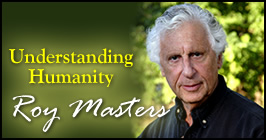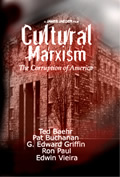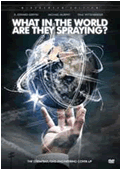PART 1 of 2
By
Roy Masters
Author of "Hypnotic
States of Americans"
May 1, 2012
NewsWithViews.com
[This article originally appeared in the October 1990 issue of “New Dimensions” magazine.]
[Be sure to read Roy’s Hypnotic States of Americans book]
Within the mind and heart of a bigot exists a hidden world of hatred, failure, and low self-esteem, combined with a powerful need to feel good at another's expense. Roy Masters (a Jewish immigrant from England who has experienced firsthand the cruelty of anti-Semitism) looks beyond the surface politics of discrimination and explores the intriguing psychology of this dangerous and divisive prejudice.
Today we are witnessing the renewal of a hate-based ideology, one based on identifying and persecuting scapegoats for personal and national problems. After the promise of the Civil Rights movement of the 1960s, people of good will the world over had hoped widespread racism would be a thing of the past. And although it has mushroomed in the last decade, this attitude of contempt for one group by another has unfortunately always been present, not only in this country, but throughout the world.
What exactly is this insidious need some people have to feel superior to other races? The answer to the riddle of racism becomes self-evident for anyone willing to probe just beneath the surface of this most inhuman of human characteristics. There are several important dynamics involved, but one of the most important is this simple but unpleasant truth: Those who have been subjected to humiliation and degradation in their own lives come under a powerful compulsion to "take it out" on someone else. Losers can feel like winners only when they look down their noses at others, and make others feel the same humiliation they have experienced.
This process is readily observed between siblings. The older brother cruelly humiliates his younger brother, who then turns around and picks a fight with his younger sister. By upsetting and degrading her, the middle child experiences what feels like a restoration of the power he lost to his older brother. Each participant in this process is unaware that his identity has been altered—each has inadvertently joined a human pecking order.
Racism often manifests a similar process. A sense of loss or violation results from failing to deal properly with the cruelty and injustice of others. Like the siblings in the story, the victim is tricked into stealing happiness from others to replace what he has lost. Although the newly created racist "power monger" may feel a rush of accomplishment, he has not really retrieved what he lost. What he gains is an illusion of strength and value. Those who are "weak before the strong" become—in their own eyes—strong before the weak. Let's call this principle "living by comparison." All those who have been psychologically and emotionally damaged, who refuse or do not know how to face their own sense of shame, are then forced to live by degrading others to minimize by comparison their own sense of loss.
The influence of negative experiences
To better understand this unconscious need to degrade, we must first distinguish it from a phenomenon that masquerades as racism, but is actually not. Negative impressions about one group or another are formed through personal experiences. Let's say a person of a particular race does great harm to you—rape, fraud, mugging, whatever. Obviously, this one experience does not prove that all persons of the same race, whether Asians, blacks, whites, Jews, or Hispanics—are bad. Yet negative experiences with individuals of a certain racial group have the effect of stigmatizing the whole group in the mind of the victim.
The victim, realizing his prejudice is based on a single experience, may be embarrassed by his hostility. He may unconsciously cover up this angry emotion by bending over backwards to be nice to the very people he secretly judges. This behavior can have the curious but observable effect of subtly enticing the same type of person (whatever his race, color, or creed) as the one who did the original harm to perpetrate a similar offense.
Several years ago, a white minister who had been victimized by two black youths decided to prove that he was not adversely affected by that negative experience. He started inviting a number of homeless blacks into his home for shelter. Some were even alcoholics and drug abusers. Although he opened his home to these people, one of them killed him. In overcompensating, and trying to cover up his negative reaction to the original assault, the poor minister lost all sense of discretion and common sense, sending out a "victim" signal to the next predator.
It is relatively easy to overcome this type of conditioning (i.e., the reflexive reaction re-sulting from a negative experience with a person which taints our relationship with people of similar characteristics). The victim must essentially become mature enough to accept the fact that although an injustice was inflicted upon him, it is neither right nor productive to hold on to his anger for the rest of his life. He must drop the resentment toward the perpetrator. Interestingly, when he does so, the event ceases to be so traumatic, and often stops being a negative focal point in his life.
Politically created "bigots"
Since the advent of "affirmative action," a new generation of "bigots" has been created, only this time misguided political solutions to racism are the victimizer. After decades of overt and obvious discrimination against minorities in hiring and housing, the pendulum has swung to the opposite extreme. Society, long guilty of setting up roadblocks for minorities, is now, in many situations, bending over backwards to see that members of those groups that have been unfairly held back are pushed ahead into positions of responsibility and power—by quotas.
Where previously a company might refuse to hire someone solely on the basis of the col¬or of his skin, that same company may now, by mandate, once again look to racial identity in hiring—but this time in order to fulfill minority quotas. The original prejudicial treatment is not undone when an injustice in the name of civil rights replaces a previous injustice in the name of bigotry.
This reverse discrimination, which allows a qualified applicant to be passed over for a job simply because he is white (and does not fulfill a minority quota), has created a backlash of resentment against those very minority groups the quota system was designed to help. Such a policy creates the impression, whether or not it is a correct one, that minorities are not hired for their qualifications. This creates self-doubt in the new hire, since he cannot be sure he obtained the job on merit alone, and hostility in the unemployed white person who assumes he was deserving of the position but got the "civil rights shaft."
The problem with this system is especially apparent when the right man gets the job for the right reasons. If he happens to be black, he may not be sure he was the most worthy applicant. There is always a somewhat difficult period of adjustment when beginning a new job, but in this case, the employee may feel doubly burdened by the belief that his new boss did not hire him freely, but out of compliance with rigid regulations. That debilitating doubt does nothing to build confidence—one of the most important components of success.
And even though he may be certain he was hired because of his skill and understanding of the operations of the business, the white man he beat out fair and square has no way of knowing this. Whenever racial differences become criteria for hiring, hard feelings and misunderstandings will always result.
The displaced worker sees anything that even hints of special treatment as a kind of theft, and blames the minority worker for usurping a career opportunity. When the economy is on a downswing, this hostility can grow to the point that an unemployed white man can begin to view all minorities as enemies, not realizing that liberal politics is the true culprit. Experience has shown that all such "reverse discrimination" accomplishes is to further heat the fires of racism and hatred.
Redefining right and wrong
But for those people who have built their lives on comparing themselves with others, racism may be largely independent of negative experience. For these self-righteous bigots, hatred is not necessarily sparked by injustice, but by a personal need to look down on others. All it requires is some identifiable difference in one's fellowman. And as many differences as exist between people, so are the number of grounds for self-righteous comparisons.
This need to compare can begin in a familiar setting: for instance, the schoolroom. One bright, inquisitive child rebels against rote learning and is labeled "stupid." The "smart students" (who may not be exceedingly intelligent, but are good conformists) look down on the outcast, who then feels drawn to other "stupid" kids. A gang mentality develops, as the rebels enjoy a common bond of hatred against the "goody-two-shoes," and vice versa. For the rebel, this process of comparison can evolve to the point that learn¬ing—even outside the school structure—threatens his good opinion of himself. In order to feel good, he has to reject learning and remain uneducated. The smart students continue to use their good grades as a reason to look down their noses at the others.
For racists, the focus of comparison is skin color:
• White against black: White supremacist groups have a sick need to feel "righteous" by identifying white as good and blacks (and all other races) as bad. With exhortations to "save the white race" these people eulogize "racial hygiene" and white unity against the "mud people" (minorities of color). From the KKK to the latest racist incarnations—the neo-Nazi Skinheads; The Order, whose members believe in an inevitable white revolution; and the Aryan Nations, whose followers advocate a migration of all white people to the Northwest—the all-consuming emotion is hatred, aroused by identifying and attacking a scapegoat.
• Black against white: Some black intellectuals, such as psychologist Dr. Naim Akbar and James Small, professor of black studies at the City College of New York, consider all whites to be racists, even those who were active participants in the '60s civil rights movement. Louis Farrakhan of the Nation of Islam claims that AIDS is a "manufactured virus" designed by white America to exterminate other races by spreading viruses and drugs.
• Black against black: In the inner cities, youth gangs attack one another over territorial rights. In Los Angeles, between 70,000 and 100,000 youths are involved with street gangs who differentiate themselves from other gangs through their colors ("Bloods" wear red, "Crips" wear blue) and hand signals. Black on black crime is a major concern in the inner cities where murder and mugging for drug money are all too common.
• Black against Asian: Many Asian-Americans have found their way into predominantly black neighborhoods and have built successful businesses; black violence against these newcomers has been on the upswing.
There are thousands of variations of racism based on this pattern of one person or group uniting with another in their common hatred of differences and experiencing a rush of su-periority over the condemned difference. This is the "hate wrong to feel right" principle. Hating an imaginary wrong or physical difference to elevate oneself into a sense of superiority over another is a very common (in)human practice. This form of self-righteous superiority is both wrong and counter-productive. It is as dehumanizing to the perpetrator as it is to the victim, so it causes more inferiority, shame, and guilt than it cures. And so the need for ha-tred—which supports the ego's illusion of righteousness—grows and becomes addictive.
We come now to the reason for finding and judging a particular "distinguishing marker"—that which differentiates one man from another, whether it be color, race, size, or intelligence. The person who is addicted to hating can work himself into a sense of being omnipotently right as judge, jury, and executioner, without fear of ever being wrong, as long as he hates a permanent characteristic. To a twisted, racist mind, a condemned feature like skin color cannot "repent" of its "sin"—can't "reform" and embarrass the "judge." So, to ensure a ready "fix" of judgment, the hateful person must condemn a feature that is unchangeable.
| Subscribe to the NewsWithViews Daily News Alerts! |
It is risky to feel superior to someone who is fat compared to your thinness. The fat person may diet, and you may put on a few pounds. This changes the delicate balance of "superiority"—a depressing and threatening prospect that can be avoided only by condemning a permanent characteristic such as color, gender, or height. The color of one's skin or slope of one's eyes, which cannot be altered, is a safe focus of condemnation for the person playing supreme judge.
Of course, this process of hating is tremen¬dously addictive. Instead of becoming more right in the process, one is becoming more wrong, less human, and therefore in ever greater need of identifying more and more wrong in the world to hate, so as to distract oneself from the guilt that always follows close on the heels of hate. For part two click below.
[To free yourself from entanglement in the intimidator’s game, you must learn to deal properly, without resentment, to pressures of any kind. My Be Still and Know meditation exercise shows you how to do this and helps you practice remaining in the proper state. You can try it before you buy it and, if you like it, purchase your own copy, at fhu.com or by calling 800-877-3227.]
Click here for part -----> 2,
Listen to Roy Masters LIVE call in radio show Monday to Friday from 9 PM to 11 PM Pacific on KDWN Radio in Las Vegas, NV.
� 2012 Roy Masters - All Rights Reserved
Roy Masters—who in his 80s continues to broadcast the longest-running counseling show in talk radio history, his internationally syndicated daily radio program Advice Line, grew up in pre-WWII England. He started his journey toward understanding human nature when as a teen he saw a stage hypnotist at a vaudeville show in Brighton. The hypnotist easily put volunteer subjects in a spell and made them do outlandish things, like dancing with a broom and forgetting their own names.
Puzzled by the hypnotist’s mysterious power, Roy distinctly remembers pondering the question: “Why can’t hypnotism be used to make people act sensibly, rather than foolishly?” Inspired by the idea of harnessing this baffling force for good, he later pursued the art of hypnotism and established a successful hypnotherapy practice.
After several years of practice, Masters made his central and pivotal discovery about the root of people’s emotional problems, addictions and complexes. He realized that people did not need hypnosis, because their core problem was that they are already hypnotized—not by a clever stage performer, but by the stresses, pressures and seductions of daily life.
He used his knowledge to discover a way to help us become de-hypnotized, and discovered that the root of the power of negative suggestion lay in our wrong emotional response, that of resentment. Masters’ remarkably effective exercise, a simple observation technique called Be Still and Know—is at the core of his unmatched track record in helping people overcome even the most serious mental-emotional problems, and is the centerpiece of a successful program within the U.S. military community (“Patriot Outreach”) that is helping thousands of military personnel and their families cope with post-traumatic stress disorder (PTSD).
1-
Website: www.fhu.com
2- Website: FixAnxiety.org











 Share
This Article
Share
This Article





